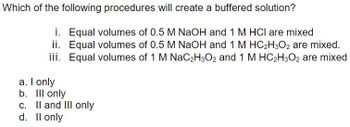
Chemistry
10th Edition
ISBN: 9781305957404
Author: Steven S. Zumdahl, Susan A. Zumdahl, Donald J. DeCoste
Publisher: Cengage Learning
expand_more
expand_more
format_list_bulleted
Concept explainers
Question

Transcribed Image Text:Which of the following procedures will create a buffered solution?
i. Equal volumes of 0.5 M NaOH and 1 M HCI are mixed
ii. Equal volumes of 0.5 M NaOH and 1 M HC₂H3O2 are mixed.
iii. Equal volumes of 1 M NaC2H3O2 and 1 M HC₂H3O2 are mixed
a. I only
b. lll only
c. II and III only
d. Il only
Expert Solution
This question has been solved!
Explore an expertly crafted, step-by-step solution for a thorough understanding of key concepts.
This is a popular solution
Trending nowThis is a popular solution!
Step by stepSolved in 3 steps with 3 images

Knowledge Booster
Learn more about
Need a deep-dive on the concept behind this application? Look no further. Learn more about this topic, chemistry and related others by exploring similar questions and additional content below.Similar questions
- Which of the following can be classified as buffer solutions?a. 0.25 M HBr + 0.25 M HOBrb. 0.15 M HClO4 + 0.20 M RbOHc. 0.50 M HOCl + 0.35 M KOCld. 0.70 M KOH + 0.70 M HONH2e. 0.85 M H2NNH2 + 0.60 M H2NNH3NO3arrow_forwardWhich of the following constitute a buffer? A. NH3 and KNO3 B. HCN & NaCN C. HF & NaCl D. NaOH & NaCl Group of answer choices C A & C B A, B and Carrow_forwardThe primary purpose of a buffer is to Select one: a. Maintain the hydrogen ion concentration of a solution b. Alter the sodium concentration of a solution c. Alter the hydrogen ion concentration of a solution d. Maintain the sodium concentration of a solutionarrow_forward
- What is the pH of a buffer made by combining 45 ml of 0.15M nitrous acid and 20 ml of 0.175 M sodium nitrite a. 3.43 b. 3.64 c. 3.28 d. 3.06arrow_forwardWhich of the following would be most effective as a buffer? A. pure water B. a mixture of molecules that are bonded to each other with hydrogen bonds C. a mixture of unbonded atoms D. a mixture of molecules with ionic bonds that will break apart into ions E. a mixture of nonpolar moleculesarrow_forwardA solution is prepared by mixing 10mL of 1 M HCI and 10mL of 1.2 M NaOH. What is the approximate pH of the solution? a. 0 b. 1 C. 7 d. 13arrow_forward
- Identify the two “active species” in each of the following buffer systems. a. HF and LiF b. Na2HPO4 and KH2PO4 c. K2CO3 and KHCO3 d. NaNO2 and HNO2arrow_forwardeade 6. In pure water, the concentrations of H₂O* and OH are equal. In an ACIDIC solution, the [H₂O*] is higher/lower (circle one) compared to [OH-], while in BASIC solution the [H3O*] is higher / lower (circle one) compared to [OH']. B. Finding the pH of Commonly Encountered Household Substances 1. Table 3. Indicator color, pH, and whether that shows the substance is an acid, base, or neutral. Acid, base, or neutral? acidic Substance Distilled water Baking soda Vinegar Lemon juice Window cleaner Seltzer water Antacid tablets Aspirin tablets Indicator color light purple turqouise Fuschia light pink green Blue light blue red pink Estimated pH 5 10 3 4 11 7 7 8 2 base acidic acidic Base neutral Base acid 2. Of all the items tested, which is the most acidic? Using the pH you determined, what is the approximate [H3O+]? 3. Of all the items tested, which is the most basic? Using the pH you determined, what is the approximate [H3O*]?arrow_forwardDuring a titration, it is found that 59.5 mL of a solution of NaOH is needed to neutralize a solution that contains 1.69 g HCL. What is the concentration of the NaOH solution? a.) 0.3535m b.) 0. 6869m c.) 0. 7790m d.) 0. 6051m e.) 1.055marrow_forward
arrow_back_ios
SEE MORE QUESTIONS
arrow_forward_ios
Recommended textbooks for you
 ChemistryChemistryISBN:9781305957404Author:Steven S. Zumdahl, Susan A. Zumdahl, Donald J. DeCostePublisher:Cengage Learning
ChemistryChemistryISBN:9781305957404Author:Steven S. Zumdahl, Susan A. Zumdahl, Donald J. DeCostePublisher:Cengage Learning ChemistryChemistryISBN:9781259911156Author:Raymond Chang Dr., Jason Overby ProfessorPublisher:McGraw-Hill Education
ChemistryChemistryISBN:9781259911156Author:Raymond Chang Dr., Jason Overby ProfessorPublisher:McGraw-Hill Education Principles of Instrumental AnalysisChemistryISBN:9781305577213Author:Douglas A. Skoog, F. James Holler, Stanley R. CrouchPublisher:Cengage Learning
Principles of Instrumental AnalysisChemistryISBN:9781305577213Author:Douglas A. Skoog, F. James Holler, Stanley R. CrouchPublisher:Cengage Learning Organic ChemistryChemistryISBN:9780078021558Author:Janice Gorzynski Smith Dr.Publisher:McGraw-Hill Education
Organic ChemistryChemistryISBN:9780078021558Author:Janice Gorzynski Smith Dr.Publisher:McGraw-Hill Education Chemistry: Principles and ReactionsChemistryISBN:9781305079373Author:William L. Masterton, Cecile N. HurleyPublisher:Cengage Learning
Chemistry: Principles and ReactionsChemistryISBN:9781305079373Author:William L. Masterton, Cecile N. HurleyPublisher:Cengage Learning Elementary Principles of Chemical Processes, Bind...ChemistryISBN:9781118431221Author:Richard M. Felder, Ronald W. Rousseau, Lisa G. BullardPublisher:WILEY
Elementary Principles of Chemical Processes, Bind...ChemistryISBN:9781118431221Author:Richard M. Felder, Ronald W. Rousseau, Lisa G. BullardPublisher:WILEY

Chemistry
Chemistry
ISBN:9781305957404
Author:Steven S. Zumdahl, Susan A. Zumdahl, Donald J. DeCoste
Publisher:Cengage Learning

Chemistry
Chemistry
ISBN:9781259911156
Author:Raymond Chang Dr., Jason Overby Professor
Publisher:McGraw-Hill Education

Principles of Instrumental Analysis
Chemistry
ISBN:9781305577213
Author:Douglas A. Skoog, F. James Holler, Stanley R. Crouch
Publisher:Cengage Learning

Organic Chemistry
Chemistry
ISBN:9780078021558
Author:Janice Gorzynski Smith Dr.
Publisher:McGraw-Hill Education

Chemistry: Principles and Reactions
Chemistry
ISBN:9781305079373
Author:William L. Masterton, Cecile N. Hurley
Publisher:Cengage Learning

Elementary Principles of Chemical Processes, Bind...
Chemistry
ISBN:9781118431221
Author:Richard M. Felder, Ronald W. Rousseau, Lisa G. Bullard
Publisher:WILEY